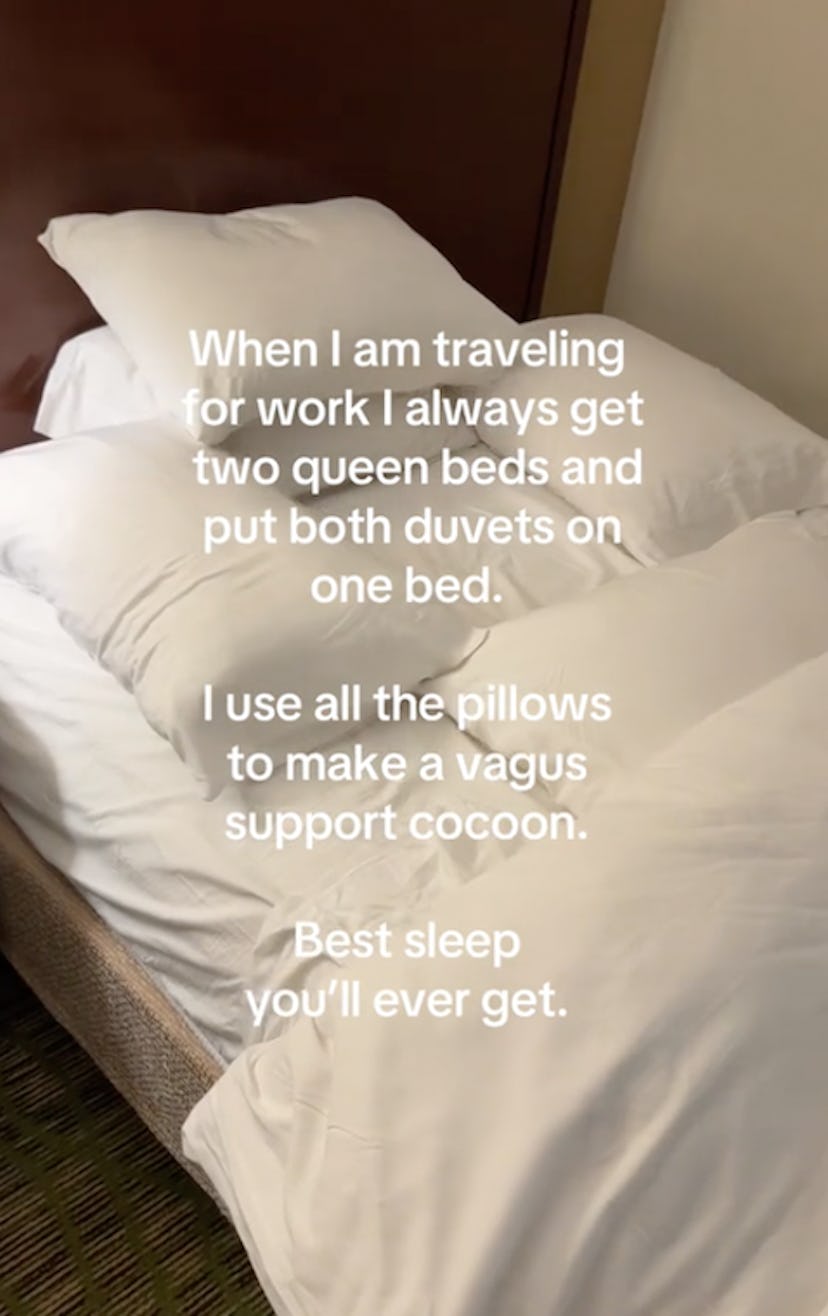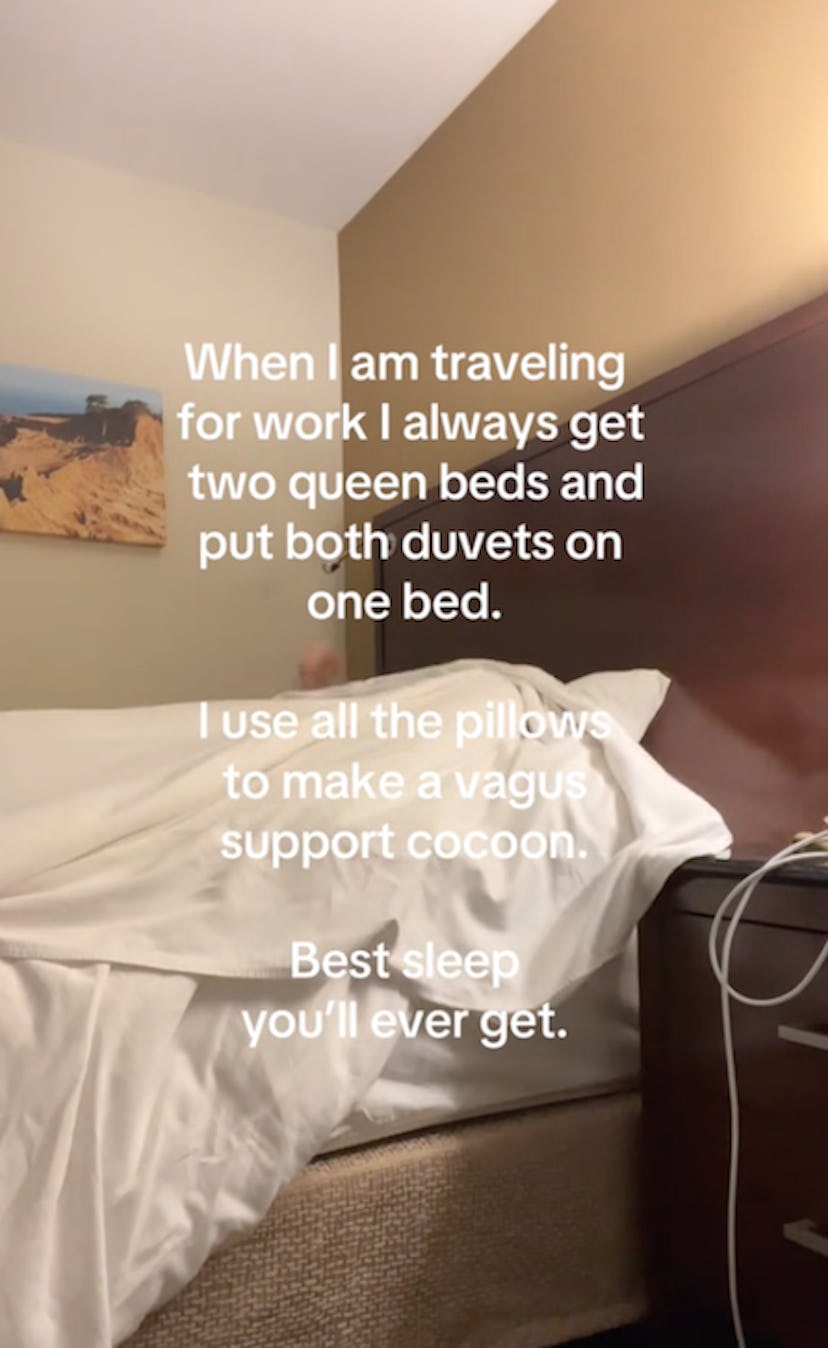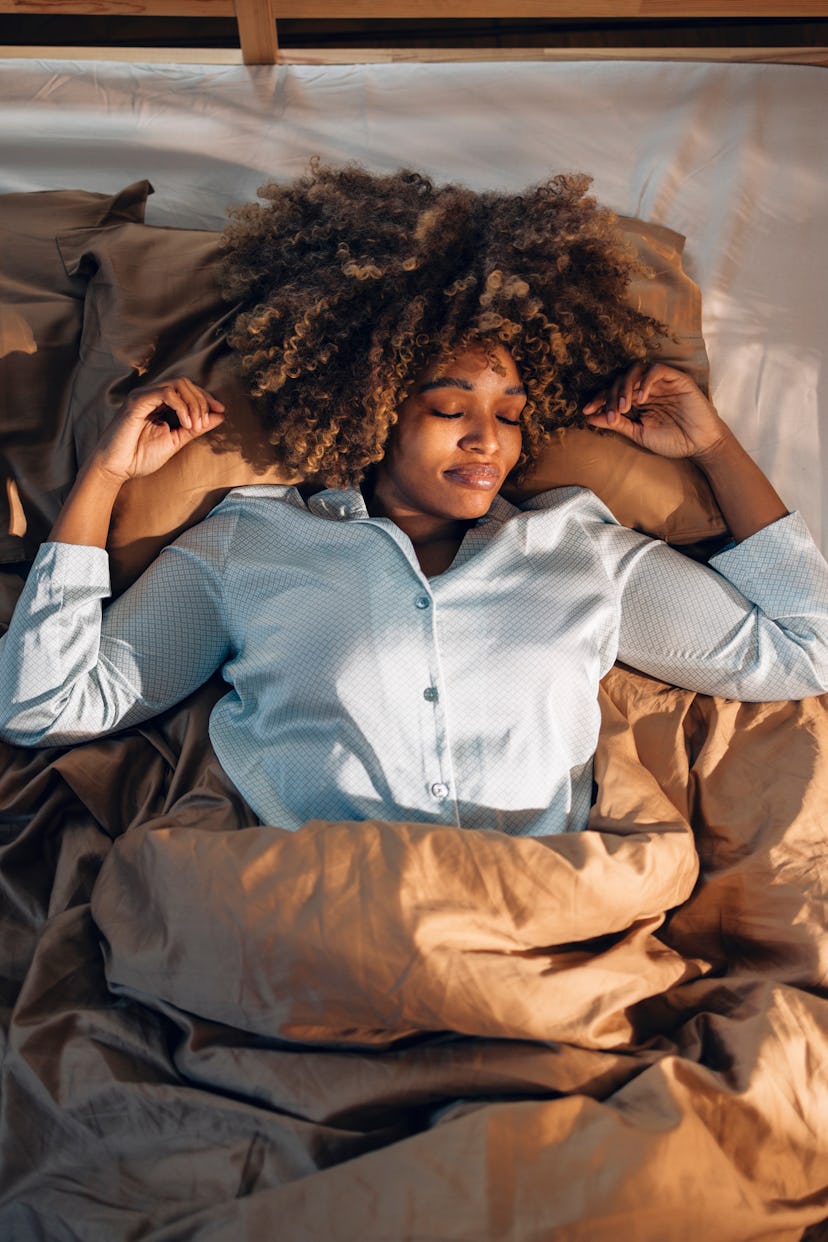When I spy a sleep hack on TikTok, I try it, then ask questions later. Recently I learned about the “vague support cocoon” technique, which involves strategically surrounding yourself with pillows to help you rest and relax. It looked very comfortable, which was good enough for me, but experts say there’s something to that, too.
The viral video that appeared on my FYP – posted June 6 by @itsmaggieperkins – shows the designer making a “cocoon” out of a stack of five pillows. She climbs into bed, leans against the pillows and pulls two heavy quilts over her. The resulting cocoon, she says, helps regulate her vagus nerve for a quality night’s sleep.
In their comments section, one person said: “There’s just something so comforting (about a) nest of pillows” while another wrote: “What you call a cocoon, my best friend and I , a “pillow corral”. Best sleep of my life. Another said: “I just remembered I used to do this as a kid. Maybe this is what I need to do again to sleep well! »
Cut to me in bed with several pillows, two of my thickest blankets – even though it’s the middle of summer – and my air conditioning on high. Here’s what it’s like to try the cocoon sleep hack, plus comments from a sleep expert on why this hack really supports your vagus nerve.
How to create a cocoon for the vagus nerve

To create an ideal cocoon for sleeping, @itsmaggieperkins layered two pillows to support her head, placed one under each arm and another under her knees to cradle her legs.
The goal is to place the pillows so that each of your limbs feels fully supported, as this is what helps your body go into total relaxation mode. (More on this below.)
To complete the cocoon, she pulled two heavy quilts over her to act almost like a weighted blanket. The designer suggested turning up the air conditioning so as not to get too hot, and also because a cold environment is conducive to sleep.
Why does the cocoon help you sleep?

According to Dr. Shelby Harris, a licensed clinical psychologist and director of sleep health at Sleepopolis, the vagus support cocoon hack involves feeling as comfortable as possible in a nest of blankets and pillows.
Most of the benefits of this sleep tip come from the fact that you’ll feel cradled and supported by your pillows, allowing your body to relax. This, in turn, sends a message to your vagus nerve that you are okay and it’s time to sleep. A regulated vagus nerve is what you want, she says, to sleep well.
“The vagus nerve is a key part of the parasympathetic nervous system, which helps regulate stress and relaxation,” Harris tells Bustle, especially after a long, tiring day. “It’s an important part of calming the body at bedtime, helping you relax, and (it has) the potential to improve the quality of your sleep.”
This cocoon also encourages you to sleep on your back, which is an ideal sleeping position for some, but Harris says you can adjust the pillows to envelop you in other sleeping positions, like on your side. “You should be comfortable and relaxed in the position that suits you best,” she says.
To further support your vagus nerve, Harris recommends sleeping in a cool room, practicing deep breathing exercises, and trying progressive muscle relaxation. “These methods can help improve vagal tone and promote parasympathetic activity,” she says. Sleeping in a cold room will also lower your body temperature, helping you fall asleep faster and stay asleep longer.
Try it

My TikTok FYP seems to know that I’m often wide awake at 3 a.m., because he regularly sends me sleeping tips. That’s how I discovered the cocoon method and why I knew I had to try it ASAP, especially as someone who usually sleeps with just two measly pillows.
I gathered all my softest cushions and an extra blanket, created a cocoon for myself, and climbed into it. With a bulging wall holding me in place, I took a few deep breaths and let myself sink into my sheets — and honestly, it felt like it was nice to have some extra support. I was officially cocooned.
The nicest part, in my opinion, were the arm cushions. I’m usually not a fan of sleeping on my back or side because I feel like I’m going to tip over, but these bumpers held me securely in place. The one under my knees was also a nice touch, as it also took some pressure off my back. According to Harris, this support is what allows your vagus nerve to kick in, and once that happens, your body should feel comfortable and relaxed enough to sleep.
As I lay there, swaddled in pillows and blankets, it felt like my muscles were melting and relaxing more than usual. The cocoon also made my bedtime routine more official. Something about setting up a comfortable place to sleep put me in the right frame of mind to doze off, and I fell asleep pretty easily too. With sleep, it seems that it’s often the simplest tips, like this, that work best.
Even though I woke up to a few pillows scattered on the floor and rolled over into my stomach sleeping position, I still loved being surrounded by a wall while I fell asleep. I can see this cocoon hack becoming a good way for me to relax before going to bed. The next time I have trouble falling asleep due to stress, I plan to return to my cocoon and let it work its magic.
Referenced studies:
Howland, R.H. (2014.) Vagus nerve stimulation. Representative Curr Behav Neurosci. doi:10.1007/s40473-014-0010-5.
Magnon, V. (2021.) Benefits of a Slow Deep Breathing Session on Vagal Tone and Anxiety in Young and Older Adults. doi: 10.1038/s41598-021-98736-9.
Average. (2024.) Sleeping for a week on a temperature-controlled mattress cover improves sleep and cardiovascular recovery. Bioengineering (Basel). doi: 10.3390/bioengineering11040352.
Tindle, J. (2022.) Neuroanatomy, parasympathetic nervous system. In: StatPearls (Internet). Treasure Island (FL): StatPearls Publishing; January 2024–. PMID: 31985934.
Wu, Y. (2022.) Transcutaneous vagus nerve stimulation could improve the effective rate of sleep quality in the treatment of primary insomnia: a randomized controlled trial. Brain science. doi: 10.3390/brainsci12101296.
Source:
Dr. Shelby Harris, Licensed Clinical Psychologist, Director of Sleep Health in Sleepopolis